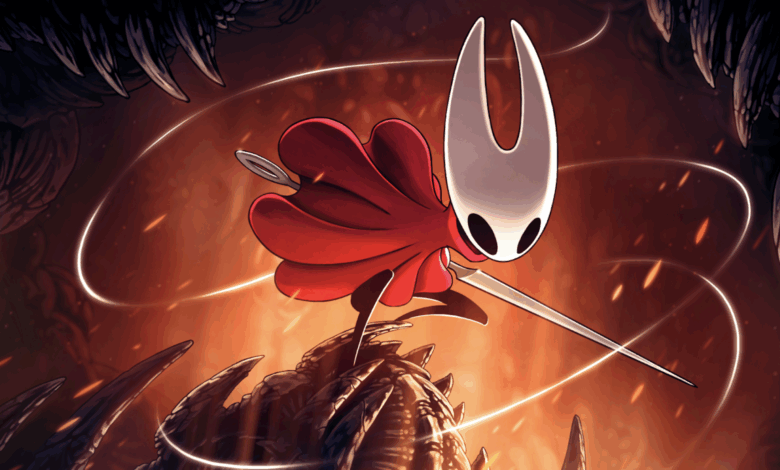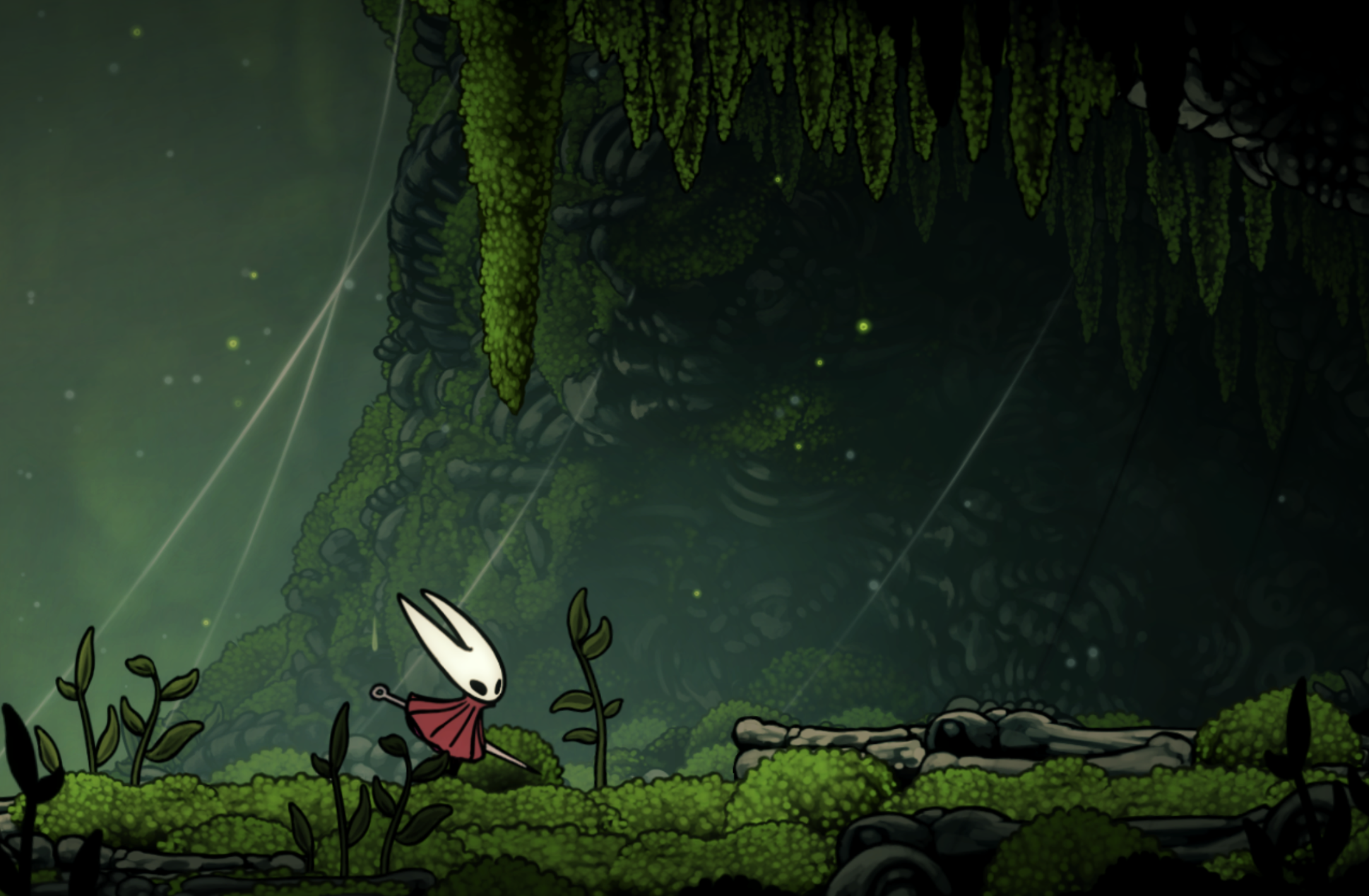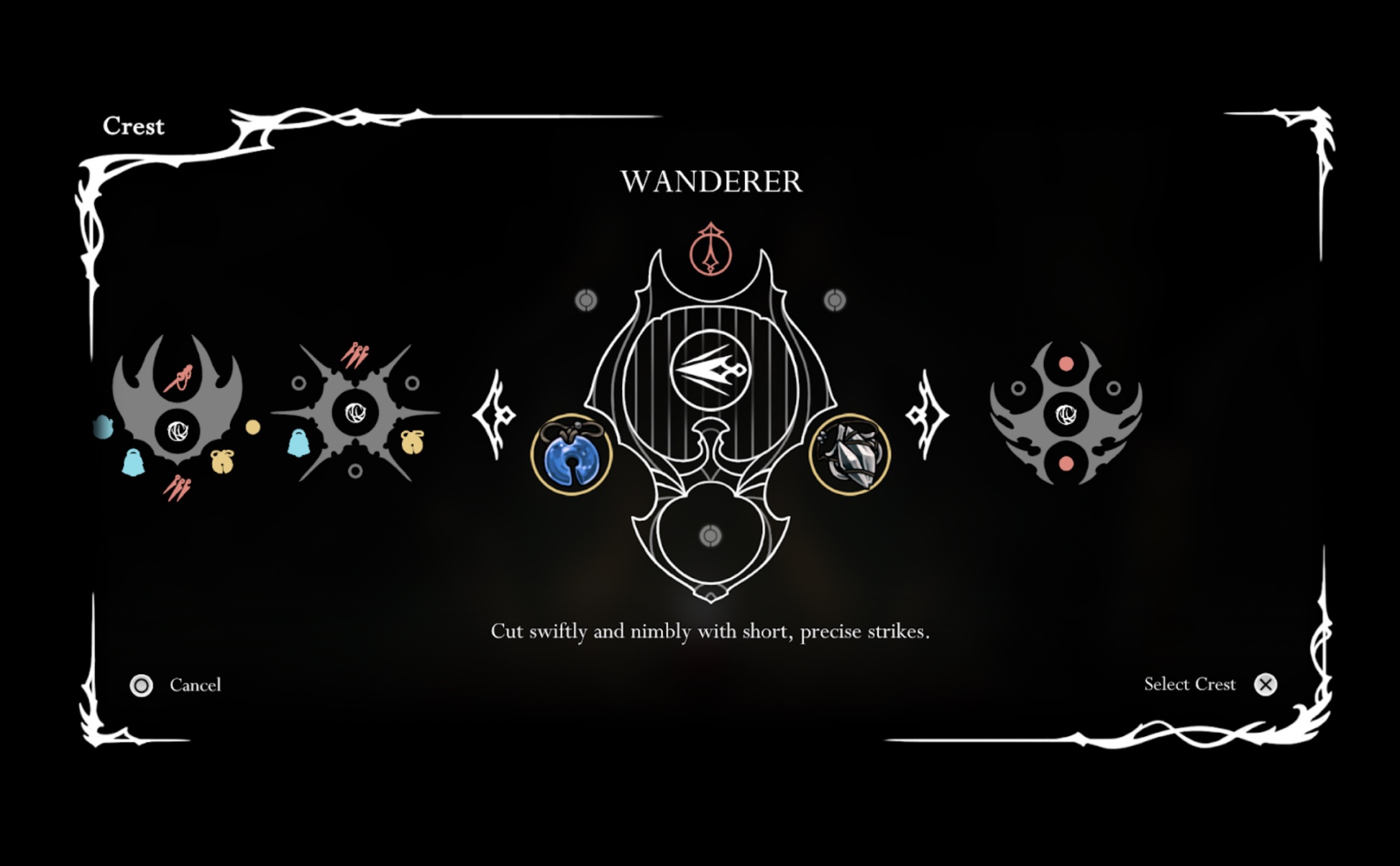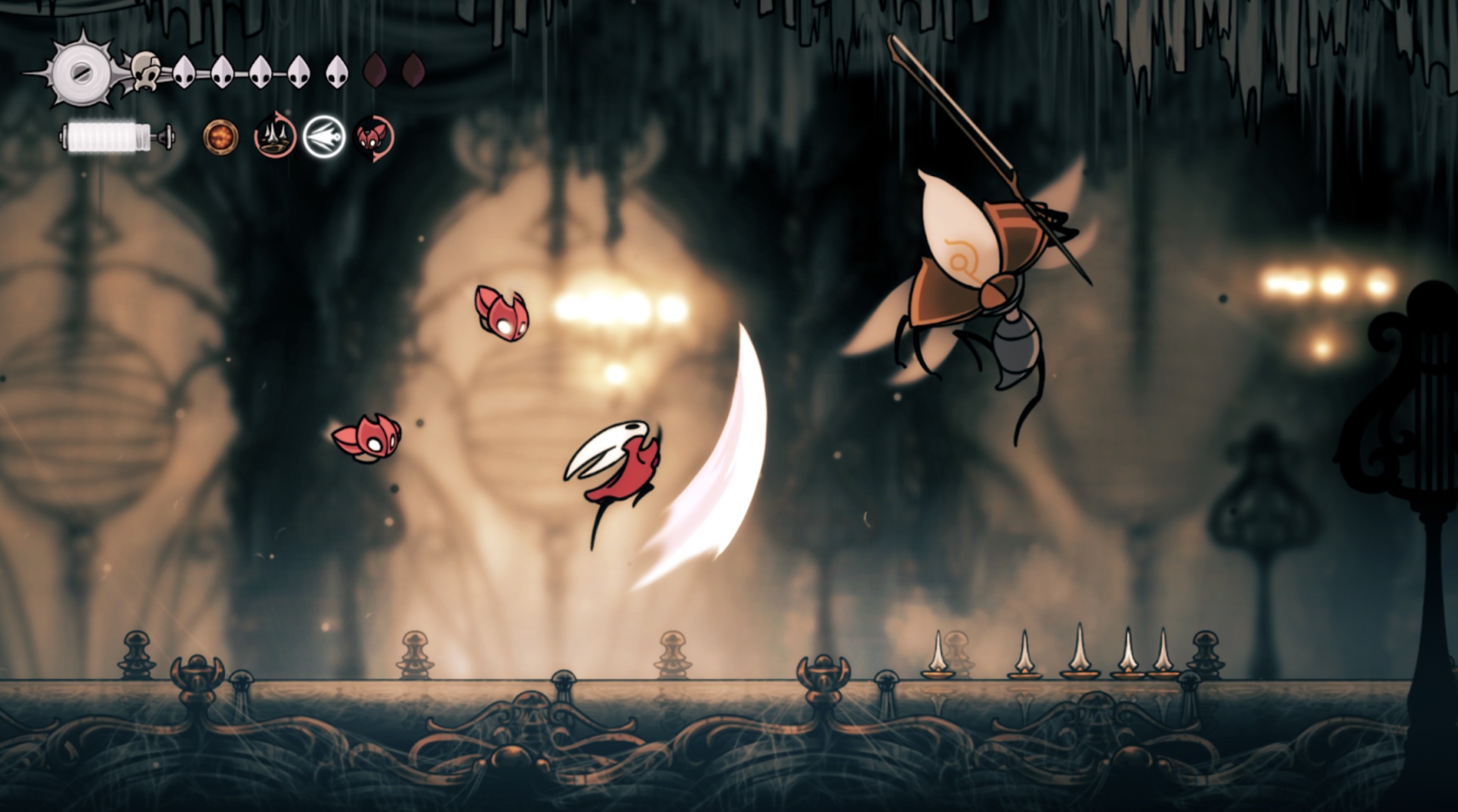Hollow Knight: Silksong Is The Polar Opposite Of Its Predecessor. Here’s Why It Works.
Spoilers ahead.

Dylan Z. Alter ’29 / Emertainment Monthly Staff Writer
“Out with the old, in with the new.”
Australian game developer Team Cherry clearly thought this when crafting the world of Hollow Knight: Silksong, the highly anticipated 2025 sequel to 2017’s Hollow Knight. Silksong, initially intended as an expansion to that game, was announced as a full-fledged sequel in 2019, with a release date ‘coming soon’.
Fans were anticipating the game’s release to be around 2021. Little did anyone know that the game would not come out that year.
During the seven-year gap between development and release, Team Cherry maintained a nearly unbroken radio silence, save for an interview with Edge magazine in 2020, an Xbox trailer in 2023, and small reassurances from their marketing director that the game was still being worked on. Excitement for the game only continued to grow, with fans on Reddit and Discord becoming increasingly extreme in their cries for the game’s release.
Silksong officially released this year on September 4th to fan acclaim. The amount of people waiting to get their hands on the game led to the collective crash of the Nintendo eShop, the Playstation Store, the Xbox store, and the Steam store for well over two hours.
Now that the dust has settled, Silksong has finally landed in the hands of over five million players.
It is in many ways an impossible thing to conceive, given just how much of a culture was built around theorizing about possible gameplay elements, narrative beats, and when the game would release. Now all of that is gone, replaced with very real discussions of the game’s narrative and gameplay elements, Silksong the game and Silksong the idea are different concepts entirely—and neither can fully take the place of the other.
With all the speculation out of the way, how does Silksong stand? Is it a worthy successor to Hollow Knight, and is it able to stand out of the shadow of that first game?
Well—without mincing words—it passes with flying colors and then some.
Spoilers Ahead.
Silksong follows Hornet, a key character from the original Hollow Knight. In that game, Hornet was the daughter of the Pale King of Hallownest, the kingdom in which the game takes place, and Herrah, the queen of a race of spiders called the Weavers (if it wasn’t clear, these games are all about bugs). She challenged the player character in two boss fights throughout the game, and provided key information responsible for getting many of the game’s upgrades and two of its endings.
As stated, Silksong was originally supposed to be an expansion of the original Hollow Knight, which would have simply made Hornet playable in the first game’s world. However, when Team Cherry began programming Hornet into the game, they realized she was too tall for several of the game’s hallways and caverns, and subsequently created a new world to suit her height.
Silksong takes place in Pharloom, a kingdom ruled by a shining Citadel at its peak. Hornet has been captured and taken to Pharloom by the bugs of the Citadel, and after breaking out of her cage, winds up at the very bottom of the kingdom—where she resolves to reach the Citadel and learn the reasons behind her capture.
Pharloom, as Hornet comes to learn, has fallen victim to a strange haunting, where pilgrims are made hostile and pulled towards the Citadel by strange silk threads that cover the kingdom.

Players can take advantage of Hornet’s more acrobatic moveset from the very beginning; even without any upgrades, Hornet is able to heal large amounts of damage with her silk spool, poke at enemies, fly over their heads, and unleash massive torrents of damage through the use of Silk Skills, the game’s magic system.
Tough situations are common in Silksong, as enemies are similarly agile and incredibly hostile towards Hornet. In addition, many enemies deal two masks (health points) of damage in a single hit, forcing players to play nearly perfectly in order to make it out alive.
However, finding the flow of combat, especially after unlocking more Silk Skills and movement upgrades, feels incredibly rewarding. In addition to Silk Skills like the Cross Stitch (which negates damage and enables retaliation against attackers), Hornet can find and purchase a spectrum of different colored tools to assist in her ascent, providing moveset alterations (yellow), passive buffs (blue), and a wider range of attack options (red). Furthermore, the discovery of crests—most of which can be found in dungeon-like areas called Chapels—change the way Hornet’s basic attacks work, and many add special status effects when Binding (the game’s method of healing). Hornet begins the game with the Hunter Crest, which provides the basic moveset, but other crests change the moveset significantly, such as the Wanderer Crest, which makes the moveset very similar to that of the original Hollow Knight, or the Shaman Crest, which changes Hornet’s basic attacks into ranged attacks that appear in large slashes.

Hollow Knight: Silksong excels in giving players options and keeping them excited to improve, though all this excitement would mean nothing without interesting areas to explore. Across the game’s twenty-nine unique areas (each one supported by incredible music from Hollow Knight composer Christopher Larkin), no two feel alike; players journey through the bright green Moss Grotto, the lava and bone-filled Marrow, the rainy and dark windmills of Greymoor, the oppressive cages of Sinner’s Road, the watery marshes of Shellwood, and the shining white and gold of The Citadel (an area so large it has over eight unique areas inside of it). Every area feels unique, and while the game does have a very clear linear path to follow, players are fully free to explore wherever they want.The most dedicated of players will of course be willing to pour hours into exploring Pharloom, but more casual players (and speedrunners) can happily follow the main path and have a wonderful time either way.
Silksong sports over forty boss encounters, each presenting one-on-one duels with Pharloom’s most dangerous foes. While bosses in Hollow Knight were typically against large bugs that towered over The Knight, Silksong‘s bosses are typically smaller, making battles feel more like dances or duels than fights.
Yet that isn’t to say that Silksong is lacking in massive, David-versus-Goliath style bosses either; bosses like the Fourth Chorus, Nyleth, and especially Grand Mother Silk (the game’s first final boss) are perfect examples of larger bosses, each one taking up almost half the screen (with their attacks just as imposing). However, none of these compare to the game’s hidden (and best) final boss: Lost Lace, a duel with a corrupted version of Lace, the game’s secondary antagonist.
Lost Lace is the third duel players have with Lace, but her new suite of ranged attacks makes the fight feel unique to the previous two encounters. Beyond the challenge and reward of mastering the fight, the narrative, music, and emotional beats in the fight take it from simple fun to one of the greatest pieces of art Team Cherry has ever produced, third only to the White Palace from the original Hollow Knight and Silksong‘s “Red Memory” sequence.
Hollow Knight set an incredibly high bar with its narrative, a tale of loss and rebirth told in bits and pieces by exploring the world and talking to optional NPCs. Silksong chooses to center its narrative squarely on Hornet and her exploration through Pharloom, in turn making said narrative far more present than that of its predecessor.
The game takes place over the course of three acts: Act 1 lasts until Hornet reaches the Citadel, Act 2 lasts until players defeat Grand Mother Silk, and Act 3 is an optional sequence that adds a new questline, shakes up the world, and allows players to duel with Lost Lace.
Act 3 contains one especially stunning sequence inside Hornet’s memory, with her memories playing out as a beautiful and touching series of cutscenes and platforming sequences, thereby revealing her childhood in Hallownest. Players even get to explore some familiar locations from the first Hollow Knight, such as the Distant Village where Hornet was born, and the White Palace, where she was raised by Hallownest’s queen. This sequence provides an end to Hornet’s character arc, as she comes into her own as a warrior and as a protector.
It is the game’s greatest moment, right above the final duel with Lost Lace.
The final section of the game, while far more linear than anything in either Hollow Knight or Silksong’s first two acts, is a perfectly climatic end to the game’s narrative. There are a suite of new and fantastic bosses, several new quests, and many new areas to explore. More than anything, however, it is the emotional beats and Hornet’s character arc that make Act 3 as good as it is.

Regardless, no game is perfect, and Silksong has its fair share of complaints from players already. Yes, the game is hard—incredibly hard in fact, which can be a warranted problem for those without a lot of time or patience for difficult games. To say, however, that Silksong is a significant step up from Hollow Knight in terms of difficulty is rather disingenuous. Hollow Knight‘s difficulty came in its exploration; even though the game is smaller overall than its sequel, the areas were far more open, with almost no linear pathways in the entire map. Silksong has a great linearity, meaning its challenges stem from an uptick in complex combat.
In many ways, Silksong is a natural evolution for Team Cherry, as Hollow Knight was already shifting its focus towards combat by the time it stopped receiving updates (its final DLC, titled Godmaster, added a boss rush mode to the game that many players view as the game’s toughest challenge). The developers built off the foundation set by Godmaster‘s boss rush challenge, as well as Hornet’s previous boss fight, and created a world tailor-made for their new character, something they will likely continue to do in DLC expansions for Silksong and in future games outside of the Hollow Knight world.
Silksong and Hollow Knight could not be more different. Where Hollow Knight focused on mastery of a small moveset, Silksong focuses on crafting a unique moveset for each player. Where Hollow Knight kept its story hidden, Silksong puts it at the forefront. Comparing the two games, while an easy trap to fall into, isn’t fair to either one.
Both games succeed at what they set out to do, but they set out to do very different things. For a world completely free to explore, where sequence-breaking is a core part of the gameplay experience, play Hollow Knight. For a more traditional Metroidvania where mastery of the combat is the focus, play Silksong.
In conclusion, Silksong is incredible. The difficulty may feel like too much for some, but for those who find pleasure in grinding a challenge until they perfect it, Silksong provides it in spades. Its skillful blend of story and gameplay makes for one of the richest narrative experiences in gaming, filled with emotional swells and charming lulls.
Those willing to give it a fair shot won’t find a game more rewarding to master or more emotionally impactful. Besides, why wouldn’t you want to experience one of the most anticipated games of all time?